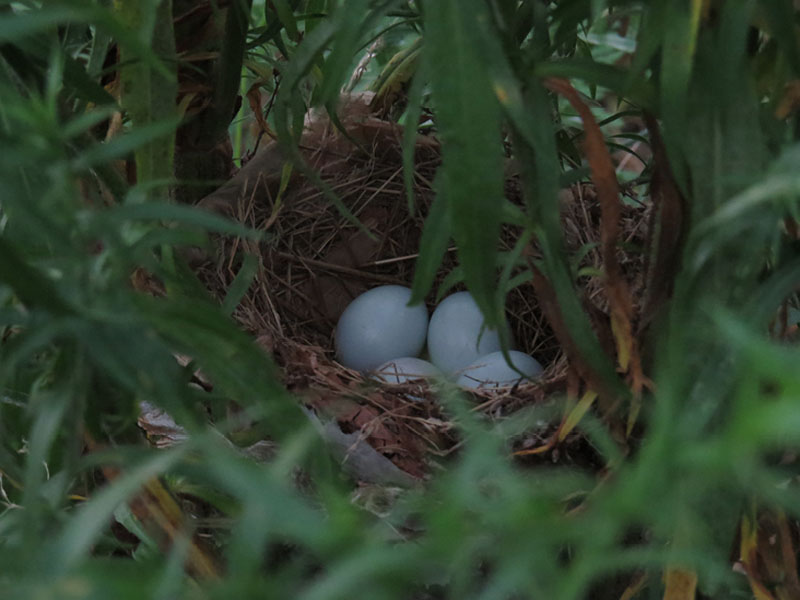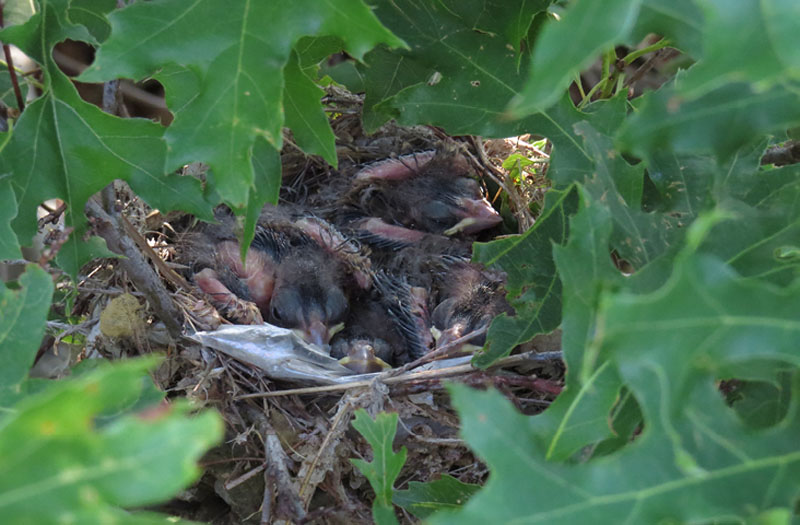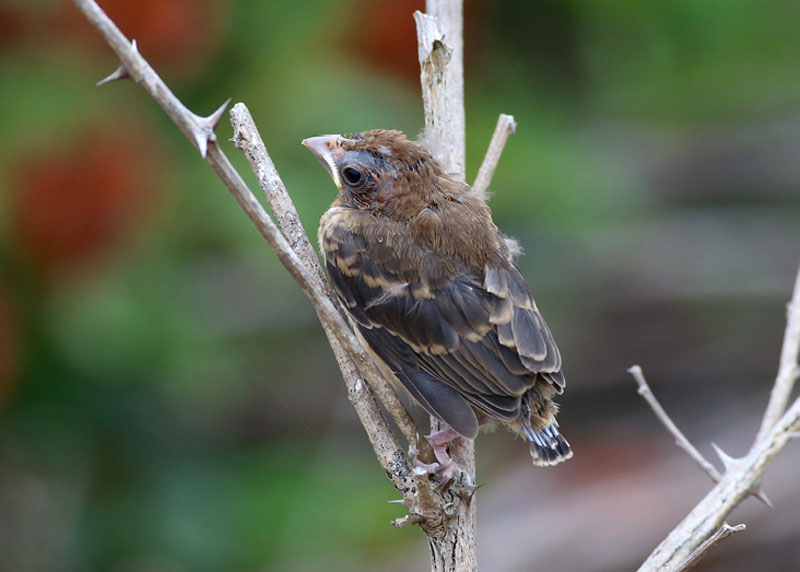Nathaniel Marchessault

Blue Grosbeak nest with eggs. Cumberland Farms, 2016. (c) author
In early August of 2016, Marshall Iliff told me that on July 28 he found the nest of a pair of Blue Grosbeaks that had been seen for the past few months at Cumberland Farms Important Bird Area (IBA) in Halifax, Massachusetts. He left me a treasure map with instructions on how to find it, and he asked that someone return to the nest in the next few weeks to check if any breeding activity had occurred. Five days later, Pete Jacobsen and I went to Cumberland Farms to try to find the nest, which we hoped would contain eggs. The treasure map proved to be just that—and even included a half-demolished trailer as a landmark. Even with the instructions, finding the nest proved to be a difficult task. But after a short time we found the nest, which contained four pearly blue eggs. This was quite a discovery because it was the first documented breeding of Blue Grosbeaks in Massachusetts. Two weeks later, Wayne Petersen and I went back hoping to find a nest with eggs or some fledglings, but we couldn’t relocate the nest. Nor did we find any adults in the area. We concluded that the nest was likely preyed upon, which caused the adults to leave the vicinity.

Blue Grosbeak nest with young. Crane Wildlife Management Area, 2017. (c) author
Fast forward a year: on July 16, 2017, two companions and I went to the Frances A. Crane Wildlife Management Area (WMA) in Falmouth, Massachusetts, for the first time since the Mountain Bluebird of winter 2015. On my way out, I bumped into Chris Neill of Falmouth. Neither of us had seen the Blue Grosbeak that Peter Crosson reported on eBird on May 25, which had been seen regularly since. After birding with Chris for a while, my companions and I left for other birding arrangements. The next morning, Chris sent me an email saying that he observed the female carrying food shortly after we left. This got me thinking as I was aware that only a male had been seen recently, and a female carrying food suggested that young may be present.
I returned after work on July 17 to see what I could find. Not knowing where to look other than somewhere near the parking lot, I hung around the general area until I started hearing the warbly song of the male Blue Grosbeak. The bird favored the kettle holes, which had lots of scrubby vegetation, so I watched as the bird hopped from place to place singing, often from the most conspicuous perch possible. The bird flew several times between the two depressions in the area, and frequently flew toward the taller trees in the field to the south. On one return flight, the bird teed up and continued to sing as usual. One major detail was different, however—the grosbeak was singing while carrying food. After making its presence well known, the bird hopped down into one of the kettle holes. Although the survival strategy of singing in the immediate proximity of one’s nest seemed to be a puzzling one, this aided my search immensely and I moved into a better position to view the general area where the bird dropped into the brush. After about twenty minutes, the grosbeak returned, again singing with food in its mouth, and flew down to some scrubby oaks. I made my way to where the bird seemed to disappear and for the first time I heard the two adults chipping. Surely that was a good sign that I was close to the nest. I continued my search for another five minutes or so before calling it a day so as not to disturb the birds too much. Before I left, I planned exactly where I would stand to have the best chance of pinpointing where the birds were bringing food.

Blue Grosbeak fledgling. (c) Alan Kneidel
On the next day, July 18, Chris met me at Crane after work and we continued our search. We stood in the exact position I noted the day before and we quickly saw the male hopping between his perches and singing. The bird made several trips away from and back to the area where we expected the nest to be, but never returned carrying food. Suddenly, Chris spotted the female carrying food and disappearing into the vegetation. We watched for her to bring food to the nest again and, making note of exactly which oak she went into, we closed in on the area. We found the nest quickly and documented the nest with four young. Better yet, we were able to do this while both parents were away from the nest—the female working hard gathering food, and the male fervently defending their territory against the rest of the clearly imaginary population of Blue Grosbeak in Massachusetts.
Chris and I were determined to find fledged young. On Saturday, July 22,Chris looked for birds out of the nest and unfortunately did not have luck, but he told me that the nest was now empty and that it was still intact with no indication of predation. On Sunday, July 23, Alan Kneidel and I got to Crane bright and early and immediately made our way to the kettle hole where the nest was, figuring the young birds would not have moved far from the nest. We walked around the general area keeping an eye out for flightless birds, but did not evoke any agitated behavior from the adults. We watched the adults moving around the area and did not see much evidence that they were actively feeding young. Just as we were about to call it quits, we heard the wit-wit-wit begging calls of a young grosbeak, and to my immense surprise we saw a stout, virtually tailless bird fly out of one of the oaks onto an exposed perch. I had no expectation that a bird that was virtually naked in the nest five days ago would be able to fly, but there it was. Alan got some spectacular documentation shots of the bird, which, like many young birds, lacked any sense of self-awareness. After appreciating the bird for a moment, we decided to leave the area so as not to disrupt them.
These two nests—the Cumberland Farms nest of 2016 and the Crane nest of 2017—are the first documented records of Blue Grosbeak nesting and fledging in Massachusetts. It is unclear if more than one young bird successfully fledged from the Crane nest, but I am optimistic in thinking that they were just difficult to find. I hope to hear of reports of a handful or more Blue Grosbeaks at Crane in the coming months before the birds head off to their wintering grounds. Blue Grosbeak appears to be another species that is expanding its breeding northward. Perhaps someday soon they will be regarded like the Red-bellied Woodpecker—and the old-timers will tell stories about how they remember going to see the first several nesting birds in Massachusetts.